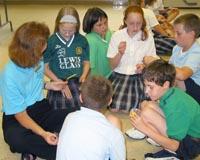Students Fold 1,000 Cranes for Peace
Students Fold 1,000 Cranes for Peace


It took nearly 3 months for the students to fold 1,000 paper cranes to send to Japan.
The story goes that a young Japanese girl named Sadako was stricken with atom bomb disease after the bombing of Hiroshima. A friend visited her in the hospital, bringing three folded paper cranes. The friend told Sadako that folding 1,000 cranes would bring peace, health and prosperity.
Sadako was only able to fold 636 before she died, but her classmates finished the 1,000 and buried the cranes with her. Since that time cranes have become a symbol for the desire for peace, and school children all around the world, including a fifth-grade 4-H club at Saint Joseph’s School in Crescent Springs, fold cranes and send them to Japan to be included in a monument dedicated to Sadako in Hiroshima’s Peace Park.
John Batey, University of Kentucky Cooperative Extension Service agent for 4-H youth development in Kenton County, said Sadako was about the same age as the fifth-graders taking part in the project. He said he sensed the students wanted to do something to promote peace.
“It’s kind of a tangible way for kids of this age to feel like they are making a difference,” he said.
Batey started the project after leading cultural lessons about Japan. He taught the students about Japan’s culture, economy, arts and much more. Students learned to make origami whales, samurai helmets and then cranes. Batey told them if they took on the challenge to fold 1,000 cranes, he would make sure the cranes got to Japan.
“I told them this is a way they can put an effort together where they can express themselves,” he said. “They can say hey, we’d like to grow up in a world that’s not full of conflict.”
Joann Nenadic teaches fifth grade at Saint Joseph’s. She said she was proud of her students for taking and meeting the challenge and being so willing to learn about other cultures.
“I teach social studies and this was a great opportunity to expand their knowledge,” she said. “We talked about where Japan is and then the language arts teacher read them the book about Sadako and the paper cranes. The whole peace connection, with the situation in Iraq, has all tied in really well for us.”
During the project, one student in the club had a chance to visit the monument to Sadako while vacationing with his family. When he returned he was able to show the students pictures of where their cranes would go and tell them about the things he saw on his visit.
“It was a one in a lifetime chance,” said Patrick Ciuccio, fifth-grader at Saint Joseph’s. “It was interesting to see all the cranes and know that ours are going out there.”
Meghan McMahon, another student participating in the project, said she folded cranes because she wants peace.
“They (Sadako’s classmates and other children) folded cranes because they wanted peace in the world,” she said. “We want peace in Iraq so we folded cranes too.”
It took the students just under three months to fold 1,000 paper cranes. Each set of 100 cranes were strung together using string and pieces of drinking straws. Batey gathered up 10 strands of cranes and will now send them to the mayor of Hiroshima.
“In 4-H every time we run a club or a program, we try to get across the four basic tenets of belonging, mastery, generosity and independence,” he said. “We incorporated all those things with this project. “
For mastery, the students had to fold a certain number of cranes; that’s mastery. They
had a feeling of belonging by being members of the club. They learned generosity by giving to something outside of themselves and they had to be independent while folding the cranes themselves.
The students also signed a letter that will be mailed with the cranes that highlights their project and their collective wish, which is the same wish engraved at the base of Sadako’s statue in Hiroshima “This is our cry, this is our prayer, peace in the world.”
